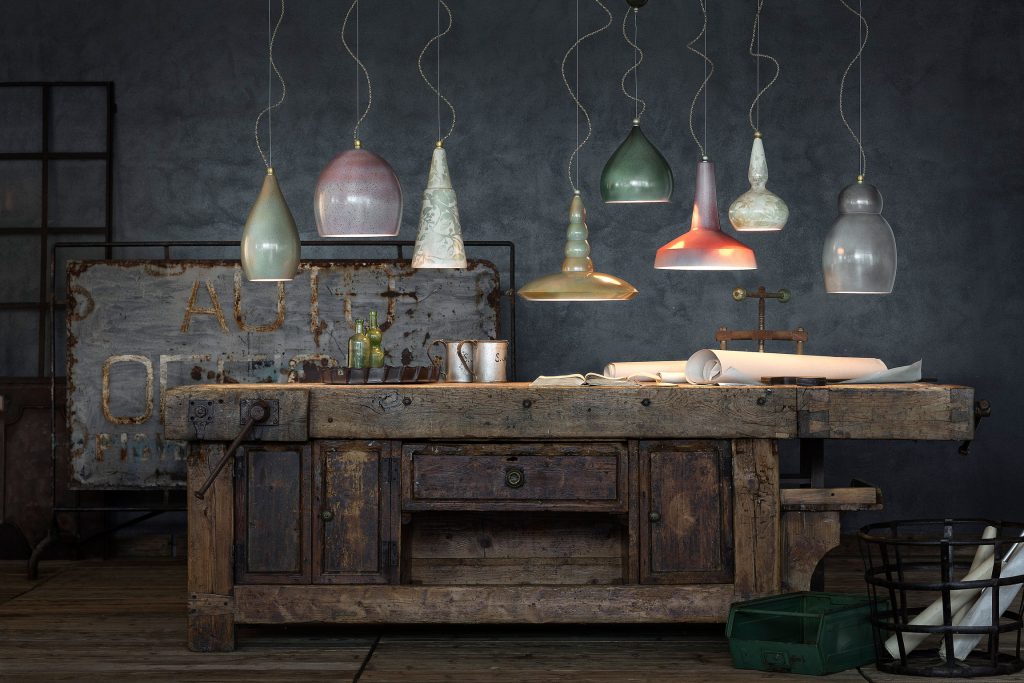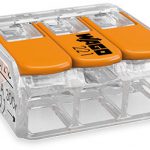Choosing and installing chandeliers and pendants

What differentiates a chandelier from a pendant? The answer is not entirely clear, but suspensions tend to be smaller, and the chandeliers always have several bulbs. In any case, their choice and installation should ideally follow a few simple rules.
1- Three types of pendants for three categories of lighting
Three main categories of pendants can be identified:
- Directed light pendants – They concentrate the light produced downwards with an opaque shade or a reflector. These lamps are perfect to illuminate an area of interest – for example a dining or kitchen table.
- In designing the overall room lighting, it is useful to estimate how much light the pendant will provide. A standard illumination for a dining or kitchen table is 200 to 300 lux. A pendant equipped with a 60W halogen bulb produces about 18 lumens per watt, and therefore about 1080 lumens overall. If we assume that 75% of this light – i.e. 810 lumens – is directed downwards, that the table is round with a diameter of 2 meters, (surface = 3.14 m²) and that the halo of the lamp mostly illuminates the table, we obtain an illumination of 810 / 3.14 = 257 lux. This is near perfect! You can play with different parameter using our calculators.
- The width of the beam is an other important parameter: if the beam is too thin, it will illuminates only part of the table and vice versa.
- For long tables, you can find rectangular suspensions, often with several bulbs, or with a linear LED. Another very elegant solution is to install several identical pendants in a line – some of these come on a rail, although the rail can be aesthetically less pleasant.
- Diffused light suspensions – Often equipped with a frosted globe or multiple small bulbs, they contribute to the overall mood of the room. The master chandeliers are part of this category.
- An frequent error is to leave the entire room illumination to a single chandelier. This gives a general light that is very “flat” and depreciates the decoration of the room.
- We recommend to equip these types of chandeliers and pendants with relatively low power bulbs, or to replace the wall switch which the control by a dimmer switch. By reducing the intensity of the light, and complementing with other fixtures with more directed lighting (table lamp, spot, floor lamp), you will compose a structured atmosphere that will be pleasant to the eye and comfortable to live in.
- Remember that compact fluorescent bulbs are not compatible with dimmers, and that the light they emit is often aggressive. We recommend using eco-halogen bulbs or dimmable LEDs.
- Suspensions – “luminous objects” – These luminaires have a decorative purpose, but contribute to the diffuse lighting of the room. These models often consist of a translucent body which lights up under the effect of the inner bulb.
- They often produce a limited amount of light produced: do not expect the lighting of a directed suspension. Their main value is to highlight the vertical space. They are therefore particularly recommended for rooms with high ceilings.
- Their size must be carefully adapted to the dimensions of the room: too small and they will appear “lost in space”, too large and they will “eat” the volume of your room and damage the balance you want to create.
- Their diffuser is often quite opaque and sometimes tinted, meaning that you can consider a variety of bulbs: a halogen, fluo-compact or LED – unless the manufacturer recommends a particular type (sometimes to avoid over-heating the fixture).
2- Practical considerations
The installation of a suspension is generally easy … provided you have an electrical outlet at the desired location! Note that in newly built homes, these arrivals are equipped with a snap point equipped with a standardized jack called DCL socket. The assembly allows easy attachment and immediate connection of the suspension, as long as the pendant is equipped with a compatible plug. If it is not the case, we do not recommend tearing the DCL socket apart, but to connect to the wire of the pendant through a suitable male connector (they are usually available in DIY stores).
If the power supply is not equipped with a DCL socket, it is imperative to ensure the electrical connection using a domino, or a similar connector. You can find these connectors in a small format, allowing an easy integration in the cone of the suspension.

We really like the Wago connectors: they are very small, they come for 2, 3 or 4 wires, and snap very easily on and off the wire (you can find them in most electrical stores, or on Amazon).
Of course, check that the hook on the ceiling is strong enough for what you hang on it …
3 – If you do not have a connector on your ceiling
Then, all is not lost. You can obviously call an electrician to install the necessary connections. If you consider installing a “master” chandelier, it will usually be quite heavy and in a large room with a high ceiling: we would anyway recommend calling a professional to help with the installation.
For less imposing pendants, you can find other solutions. Some manufacturers propose “offset” fixtures: a box connects to an electrical socket on your ceiling at a distance from the zone of interest, and an elegant wire (usually one or two meters) jumps to the pendant. Another solution, quite elegant with pendants of “industrial” style, is a copper or brass tube that runs along a wal and the ceiling to conduct the wires to your pendant. We work with one or two outstanding Italian manufacturers who specialise in these fixtures. They are usually manufactured to the dimensions of your room, and we can provide them if you ask.
Where can you find our pendants?
We propose a large selection of pendants and chandeliers, of all styles:
- In our contemporary category, the pendants themselves, and the chandeliers (usually with more than one branch), and ceiling lights;
- In our classical range, you will find a truly magnificent selection of chandeliers by Lucien Gau, who has been manufacturing superb luminaires for more than a century, in solid brass and in the pure styles of Louis XII, Lous XIV, Louis XV and XVI, and then Empire and later. Estro is an Italian designer who does beautiful and luxurious classical lamps with stunning handicraft.
- Finally, our outdoor range also has many pendants that can just as well find their place indoors, and ceiling lights that have the advantage of being fully waterproof and therefore can fit very well in a bathroom or above your indoor swimming pool!
* * *
You can find further guidance in the following page:
- Our advices to dimension your lighting and choose your fixtures: the principles of lighting design.
- Which types of bulbs you should choose, from all the technologies now on the market - fluo-compact, LEDs etc: what you need to know about bulb technologies.
- How you should choose the LED you need, depending on your room and your expectations in terms of lighting (there is more to it than what you can read on most bulb packages): our guide to choosing LED bulbs.
- Explanation of what the various lighting units mean, and how to use them: how to speak the jargon, with lux, lumen and candela!.
- Use our calculators to size your lighting according to its purpose: our lighting calculators.
- Find your way in the jungle of the various European bulb types: our simple guide to the various bulb models.
- Read our advice on why you could consider connected lighting, and how you can jump on the train without the headaches: starting with connected lighting.
You can also find below our advice to choose and install the various types of lighting you can find in our catalogue:
- suspensions, chandeliers and pendants
- Table and desk lamps
- Wall lights
- Lighting beacons for circulation areas (indoor or outdoor)









